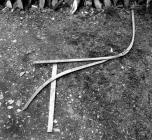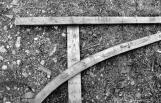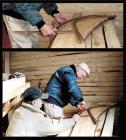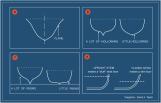1
The three-piece mould2003
Winterton Boat Building and Community Museum, Newfoundland and Labrador, Canada

2
In Winterton there were several different methods used to shape the hull timbers (frames) for traditional boat construction. These were the three-piece mould, the full mould, and the half-model method.It has been documented that in the earlier times all the hull timbers (frames) were shaped out using this three-piece mould. In later years, builders used the method to obtain the shapes of the mainframes only: the fore hook, mid-ship bend and after hook. It appears that the later generation of builders for some reason had not learned to use these moulds to the fullest extent. One can speculate that some of the sir marks (pencil marks showing the position of each piece to form different timber shapes) became indistinguishable because of fading over time. In any event, once the three main frames were shaped and fastened to the keel (straight piece of wood running the length of the bottom of the boat) the shape of the remainder of the hull could then be obtained through the use of several battens (or ribbands). These were bent around the three frames and attached to the counter (back of the boat) and stem (front of the boat), one foot or so apart on each side of the hull.
While the three-piece adjustable mould was widely used it was not designed to give the shape of the stem or the angle of the stern. Therefore, the shapes of the boat ends had to be determined by other means. These shapes were selected by each builder based on memory or mental templates that came from experience. The choice of stem shape or the angle of the stern piece to the keel could greatly affect the hull shape and thus the boat's overall performance. Depending on the stem shape, whether it was more upright or flared more outward, the bow of each boat was different. A more upright stem, for example, could mean a fuller or wider bow. This was one way in which boats of different builders were easily recognized as they entered the harbor from the fishing grounds.
3
Three-piece mould used to build a 16' rodney (punt)May 1979
Winterton, Newfoundland, Canada
 Credits:
Credits:photo by David A Taylor
4
The contemporary use of adjustable moulds in the designing of boats is thought to be extremely rare. In addition to Winterton and other small Newfoundland communities the present-day use of moulds of this kind has only been documented in coastal communities in Greece, Portugal and Brazil.This system of designing vessels, sometimes called whole-moulding, was originally employed for the design of ships. Documentary evidence suggests that it probably originated in Europe around the middle of the seventeenth century. However, some scholars have argued that the use of adjustable templates of a similar type can be traced back as far as the fifteenth and sixteenth centuries, in Venice.
The adjustable moulds used by Winterton boatbuilders are virtually identical to those described in Mungo Murray's Treatise on Ship-Building and Naval Architecture, which was published in London in 1765. Furthermore, the terms used by Murray to identify the various parts of the moulds are also very similar to the terms used by Trinity Bay boatbuilders who "build by the mould."
5
Detail of the three-piece mould showing sir marksMay 1979
Winterton, Newfoundland, Canada
 Credits:
Credits:photo by David A Taylor
6
It is not possible to determine when, or by what means, whole-moulding came to Trinity Bay. However, based on the fact that the region's first settlers came from the West Country of England in the mid-seventeenth century, it is probably safe to assume that knowledge about how to use adjustable moulds was brought from England by these settlers or those who followed them.The earliest documented evidence of mould use around Trinity Bay is
"An Inventory of the Effects of John Brine, Boatkeeper, deceased of Trinity 1805." In addition to various woodworking tools and fisheries-related items, the inventory of Brine's possessions includes one set of skiff moulds and three sets of punt moulds. While the inventory doesn't reveal the composition of these moulds, it is possible that they were three-part adjustable ones.
To watch a Winterton boatbuilder use adjustable moulds to design a boat is to watch a vestige of a very old system of naval architecture that can be seen in action in very few places around the world.
7
Using three-piece moulds to mark timber pieces for shaping2003
Winterton Boat Building and Community Museum, Newfoundland and Labrador, Canada

8
In 2002 an Italian gondola builder visited the Winterton Boat Building and Community Museum. He was delighted to find that Winterton's traditional technique of building boats using moulds was the same as the method he used to build gondolas.The matter-of-fact, take-it-for-granted approach to boat building was typical among the fishermen/boatbuilders of Winterton. They went about boat building in a traditional way. That is, they acquired knowledge that was passed on to them by the previous generation, mainly by word-of-mouth and observation and imitation. For example, boys watched and helped when their fathers were building boats, and gradually accumulated the knowledge needed to build fishing boats in the local way.
In Winterton, distinctive construction techniques and variations of boat designs emerged. Consequently, fishermen could readily distinguish Winterton-built boats from boats built in other communities.
Winterton boatbuilders paid careful attention to the conditions in which a boat would be used and modified their designs accordingly. For example, boats that were to be used mainly in the rough waters around Baccalieu Island (at the entrance to Trinity Bay) were shaped differently than boats that were used mainly in the calmer waters of the inner Bay.
9
Using full moulds to shape boat construction2003
Winterton Boat Building and Community Museum, Newfoundland and Labrador, Canada

10
Another method used to pass on hull shapes was the construction of full-size moulds showing the fore hook, mid-ship bend and after hook. Often a mould of the counter shape would also be constructed. These were made of two or three sections of naturally curved wood and were used as patterns from which actual main frames were to be constructed. In a later building technique whereby frames were made of steam-bent lathes instead of naturally curved pieces, such full-size moulds were laid on the keel and used temporarily with battens until all steam-bent frames were installed, after which the main frame moulds were removed.12
In Winterton there was limited use of the half-model method, a design approach more widely used by other boatbuilders. Amos Piercey, who built a limited number of schooners here, used this approach and there is evidence of one or two others using the half-model for the construction of motorboats.For most boat building the three-piece mould and full mould were much more popular, probably because these were simpler to use and did not require scaling or other calculations.
13
Changes in the shape of the boat's hull2003
Winterton Boat Building and Community Museum, Newfoundland and Labrador, Canada

14
Some time during the first or second decade of the twentieth century one-cylinder, gasoline engines became available to fishermen of Winterton as they did elsewhere in North America. The coming of the make-and-break engine led to major changes in boat design. The stern assembly was changed to accommodate the engine shaft and propeller as well as provide more bearing aft (at the stern), for the extra weight of the engine itself. The over-hung transom stern was designed using a new arrangement of knees.Before engine power, inshore fishing boats were kept small because they had to be rowed to and from the fishing grounds. Powered by engines, boats could be made longer, wider and deeper. Fishermen could fish further from shore and boats could carry more fish. At this time we see the development of larger trap skiffs, able to carry more fish and handle larger traps, and other motorboats used for trawling further out on the edge (the area where the bottom changed from shallower rocky ground to deeper muddy or sandy ground), in greater depths of water. The increased speed and further distances also led to changes in the bow design. As engines improved and horsepower increased more flare was needed at the bow of open boats to throw away the spray from oncoming waves when steaming to windward.
